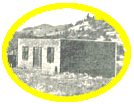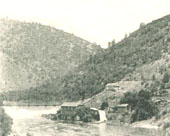The following is an excerpt from a 1907 Brochure/Public Time Table.
It discribes the rail journey from Merced to El Portal. The gateway to the
Yosemite Valley over the Yosemite Valley Railroad.
 OSEMITE IS OPEN Spring and Summer, Autumn and Winter, and
he would be a rash man who should venture to say at what
season this wonderful Valley looks most beautiful.
OSEMITE IS OPEN Spring and Summer, Autumn and Winter, and
he would be a rash man who should venture to say at what
season this wonderful Valley looks most beautiful.
The trains of the Yosemite Valley Railroad run every day
from Merced to El Portal the Gateway of Yosemite.
MERCED, the western terminus and headquarters of the
Yosemite Valley Railroad, is a pretty little city in the San
Joaquin Valley, about 145 miles south of San Francisco. It
is on the maim lines of the Southern Pacific and Santa Fe,
and thus has excellent train service from all points in
California and the East. The schedules are given on last
page.
The Yosemite train, on leaving Merced, crosses one of the
riches and most fertile section of the San Joaquin Valley.
On every side are orchards, vineyards, prosperous farms,
rich pastures and herds of sheep and cattle, while in the
distance glisten the silver peaks of the towering High
Sierras.
At Merced Falls the line reaches the entrance to the Merced
Canyon. Soon a change comes over the beautiful Merced River.
In place of a broad, placid stream, rippling over pebbly
reaches past ideal picnic and camping grounds like Shepard's
Point, or deep, sunny pools where the trout lurks in
seclusion, the river is pent in between the narrow walls of
the canyon and rushes in foaming cataracts over the rocks
and boulders strewn in its pathway. For sixty miles the
railway line follows the course of the river, through the
gorge, crossing and recrossing, with fine engineering skill,
and only once or twice for a few moments is the river out of
sight and hearing.
At Exchequer the river is thirty feet deep, and, pouring
over the dam with an 18-foot fall, furnishes 500 horsepower
for the electric power plant nearby.
 Constantly we are reminded of past historic days, when the
pioneers were panning and sluicing the rivers of California.
Piles of stones, worn smooth by the water, acres of small
rocks bear witness to the feverish activity which
characterized the search for gold. At one bend in the river,
close to the shore, stands a small, square, stone building,
windowless, roofless, but with stout iron doors and
shutters, which was once a bank for the miners' precious
dust. It is an interesting monument of an epic period -
Constantly we are reminded of past historic days, when the
pioneers were panning and sluicing the rivers of California.
Piles of stones, worn smooth by the water, acres of small
rocks bear witness to the feverish activity which
characterized the search for gold. At one bend in the river,
close to the shore, stands a small, square, stone building,
windowless, roofless, but with stout iron doors and
shutters, which was once a bank for the miners' precious
dust. It is an interesting monument of an epic period -
"The days of old
The days of gold,
The days of '49."
|
 The Bagby Dam is the most picturesque along the course.
Pouring over with a constant roar, like a great sheet of
moving glass, until it breaks in snowy foam below, it form a
picture for which every visitor should get his camera ready.
Bagby was formerly known as Benton Mills, which were named
after Jessie Benton, wife of General Fremont, and daughter
of Senator Benton, of Missouri.
The Bagby Dam is the most picturesque along the course.
Pouring over with a constant roar, like a great sheet of
moving glass, until it breaks in snowy foam below, it form a
picture for which every visitor should get his camera ready.
Bagby was formerly known as Benton Mills, which were named
after Jessie Benton, wife of General Fremont, and daughter
of Senator Benton, of Missouri.
At Mountain King is a 20-stamp mill, which is operating by
water brought along a flume from the intake at a point three
miles up the river.
At South Fork the main river and the south fork come
together in picturesque confusion, and apart from the beauty
of the scene, it may well and truly be called the
Fisherman's Paradise. It is of interest to note that the
famous Hite's Gold Mine is only four miles up the South
Fork. Keep your camera ready, and soon you will get a view
of the emerald wonder, Mossy Canyon, which will enrich your
store of negatives.
Winding and curving, twisting and turning, ever climbing, we
now reach the Hog's Back, a curve which almost completes the
circle; then there is a sudden sweep to the right, and far
up, 2000 feet above us on the face of the great cliff is a
narrow, white band which shimmers in the light as you gaze.
You are looking at the Chinquapin Falls, and the first part
of your journey is over. For you have reached El Portal, the
Gateway of Yosemite.
 EL PORTAL. Here let us pass the night, for surely a more
delightful spot could not be found. On a rocky plateau,
above the murmuring river, surrounded by trees, which the
cliffs of the canyon standing like giant sentinels on guard,
the homelike hotel, El Portal, throws wide open its
hospitable doors. This fine hotel cost about $100,000. The
25-foot verandas on three sides, the large rubble
fireplaces, the spacious entrance hall with its heavy beamed
ceiling, and attractive dining room, all make for comfort
and enjoyment. The 135 rooms are well and conveniently
furnished, and the beds are the best that money can buy.
There is a Palm Garden in the rear of the hotel, and a Band
Stand over the main veranda. Mr. Wm. Sell, the manager, who
is known to many travelers, personally superintends the
service in the dining room, with the result that everything
is the best of its kind. His early trout breakfast is worth
getting up early to enjoy.
EL PORTAL. Here let us pass the night, for surely a more
delightful spot could not be found. On a rocky plateau,
above the murmuring river, surrounded by trees, which the
cliffs of the canyon standing like giant sentinels on guard,
the homelike hotel, El Portal, throws wide open its
hospitable doors. This fine hotel cost about $100,000. The
25-foot verandas on three sides, the large rubble
fireplaces, the spacious entrance hall with its heavy beamed
ceiling, and attractive dining room, all make for comfort
and enjoyment. The 135 rooms are well and conveniently
furnished, and the beds are the best that money can buy.
There is a Palm Garden in the rear of the hotel, and a Band
Stand over the main veranda. Mr. Wm. Sell, the manager, who
is known to many travelers, personally superintends the
service in the dining room, with the result that everything
is the best of its kind. His early trout breakfast is worth
getting up early to enjoy.
The entrance to the Yosemite National Park is only a short
distance from the El Portal Hotel, and the twelve and
one-half miles of roadway from El Portal to the Yosemite
Village is under Federal supervision.
The coaches of the Yosemite Transportation Co. - D. K.
Stoddard, manager - are roomy and comfortable. This is a
most enjoyable drive.
..
..
..
(The story continues on for several
pages
highlighting the attractions of the National
Park).
..
..
..
Through tickets sold by all Southern Pacific and Santa Fe agents.
Baggage checked through to Yosemite. Free allowance on railroads, 150 pounds; on stages, 50 pounds; excess baggage, $1.00 per cwt (hundred weight.)
On Application, Southern Pacific and Santa Fe conductors will issue stop-over checks at Merced on all classes of overland tickets.
A regular vestibuled passenger train leave Merced daily, with observation car on the rear. A small additional charge is made for seats in the observation car.
An eight-passenger motor car is in service between Merced and El Portal, which can be chartered for a special trip at any time. This makes an ideal automobile trip up the Merced River Canyon.
The Yosemite Valley Railroad train going into the Valley, will stop at the Santa Fe and Southern Pacific stations, to pick up passengers, and will also land passengers at both these stations when returning from the Valley.
..
..
.. (Page continues with tables of distances and altitudes in the
Valley and
railroad schedules for the Southern Pacific, Santa Fe and Yosemite Valley.)
|